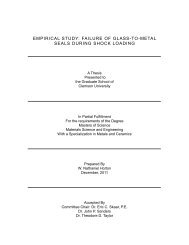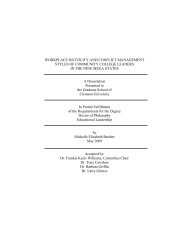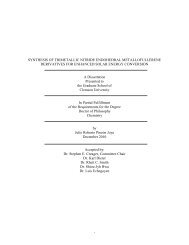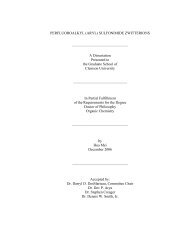- Page 1 and 2: MONUMENTAL-IT: A “ROBOTIC-WIKI”
- Page 3 and 4: Results strongly suggest that the f
- Page 5 and 6: ACKNOWLEDGMENTS “Perhaps the miss
- Page 7 and 8: TABLE OF CONTENTS TITLE PAGE ......
- Page 9 and 10: Table of Contents (Continued) 6.1 Q
- Page 11 and 12: LIST OF TABLES Table Page 3.1 Conce
- Page 13 and 14: List of Figures (Continued) Figure
- Page 15 and 16: List of Figures (Continued) Figure
- Page 17 and 18: List of Figures (Continued) Figure
- Page 19: List of Figures (Continued) Figure
- Page 23 and 24: memory environments are confronting
- Page 25 and 26: information, the use of architectur
- Page 27 and 28: 1.3 State-of-the-art of monuments M
- Page 29 and 30: architectural system that interacts
- Page 31 and 32: (2) Adaptation: an organism “must
- Page 33 and 34: Using the cybernetic analysis, imit
- Page 35 and 36: CHAPTER TWO LITERATURE REVIEW ON MO
- Page 37 and 38: 1982, p.8). The function of a monum
- Page 39 and 40: an aarchitecturall historian, ddesc
- Page 41 and 42: pressence wouldd still remaain in t
- Page 43 and 44: nomadic culture and movement, “th
- Page 45 and 46: (Berrman, 2008) ). Berman’s resea
- Page 47 and 48: Similarly, “Memodules” is a Tan
- Page 49 and 50: with the actual recollection of the
- Page 51 and 52: “Abrias” is a digital interface
- Page 53 and 54: simuulate fire ( (Dalsgaard, 2008,
- Page 55 and 56: (Ruffaldi et al., 2008); integratin
- Page 57 and 58: 2.3 Architecture and Information Te
- Page 59 and 60: embbedded into the built environmen
- Page 61 and 62: are close to itss proximity sensors
- Page 63 and 64: The environment affects the way we
- Page 65 and 66: 2.5 Interpretations of historical d
- Page 67 and 68: Monuments tend to be immobile, heav
- Page 69 and 70: 2009, p.23). Post-Phenomenology “
- Page 71 and 72:
CHAPTER THREE CONCEPTUAL FOUNDATION
- Page 73 and 74:
Figurre 3.1 Diagrram showing operaa
- Page 75 and 76:
partially shape the memory in the w
- Page 77 and 78:
through the whole body, not only th
- Page 79 and 80:
may not do what the users want to d
- Page 81 and 82:
histoory of archiitecture (Zuuk and
- Page 83 and 84:
Each design alternative has been na
- Page 85 and 86:
Concept Description A: Rotating Tub
- Page 87 and 88:
Concept Description Underlying Kine
- Page 89 and 90:
anked higher,” (Ulrich and Epping
- Page 91 and 92:
eliable instrument for the advances
- Page 93 and 94:
Strauss II’s music “Perpetuum M
- Page 95 and 96:
expllicitly desiggned to exxplore s
- Page 97 and 98:
actuuated using NNylon stringgs anc
- Page 99 and 100:
of bolts and nutts, (Figure 33.11-r
- Page 101 and 102:
Five usability and architectural-ro
- Page 103 and 104:
obootic technology to formm Monumen
- Page 105 and 106:
CHAPTER FOUR RESEARCH PROTOTYPE: A
- Page 107 and 108:
Megan Fox and Lauren will present a
- Page 109 and 110:
history of slavery and a database f
- Page 111 and 112:
data, it will also draw upon the in
- Page 113 and 114:
Figurre 4.2 F- Visitors are sitting
- Page 115 and 116:
conttaining a "baarracoon" [sslave
- Page 117 and 118:
4.3 TTechnical ddesign The strructu
- Page 119 and 120:
Figurre 4.8 Assembbling the base fo
- Page 121 and 122:
connnection fromm 2400 to 4460800 b
- Page 123 and 124:
“Perrpetuum Moobile - A MMusical
- Page 125 and 126:
Figurre 4.15 Monummental-IT’s Fee
- Page 127 and 128:
Figurre 4.17 WikiMMonument webbsite
- Page 129 and 130:
Tablee 4.1 WikiMoonument database o
- Page 131 and 132:
(Figure 4.19). With Monumental-IT u
- Page 133 and 134:
4.4 Modes of operation As described
- Page 135 and 136:
CHAPTER FIVE HEURISTIC EVALUATIONS
- Page 137 and 138:
5.2 WWikiMonument and ccognitive wa
- Page 139 and 140:
as too the similaarities betwween W
- Page 141 and 142:
WikiMonument’s webpages (Figure 5
- Page 143 and 144:
was created using the following var
- Page 145 and 146:
eported that the design of the inte
- Page 147 and 148:
design. Further research is recomme
- Page 149 and 150:
Five exxperts (“insspectors”) w
- Page 151 and 152:
(4) speak to the microphone to expr
- Page 153 and 154:
minute debriefing session, about hi
- Page 155 and 156:
violates the “aesthetics and mini
- Page 157 and 158:
abouut the monnument (Figure 5.8).
- Page 159 and 160:
CHAPTER SIX QUASI-EXPERIMENTAL DESI
- Page 161 and 162:
IT, tthe sound leevel and the posit
- Page 163 and 164:
experimental Designs for Research,
- Page 165 and 166:
As for mitigating threats to extern
- Page 167 and 168:
The pretests and posttests were des
- Page 169 and 170:
to participate in the second part,
- Page 171 and 172:
probbable visitoors of monuumental
- Page 173 and 174:
as “nnormally afffective,” annd
- Page 175 and 176:
helping to determine the effectiven
- Page 177 and 178:
“feaar,” while 3.1% were mmissi
- Page 179 and 180:
For the “yellow” coonfiguration
- Page 181 and 182:
Figurre 6.10 Participants’ respon
- Page 183 and 184:
Quoote three: “I does worryy ‘b
- Page 185 and 186:
the previous reesults on thee effec
- Page 187 and 188:
CHAPTER SEVEN CRITICIAL DISCUSSIONS
- Page 189 and 190:
complex form of social-interactiona
- Page 191 and 192:
assessing these differences is impo
- Page 193 and 194:
configurations on the human-robotic
- Page 195 and 196:
Figure 7.2 Monumental-IT’s social
- Page 197 and 198:
The test results from the human-rob
- Page 199 and 200:
used the computer science engineeri
- Page 201 and 202:
provides new evidence for the appli
- Page 203 and 204:
fulfill a wide range of needs, or w
- Page 205 and 206:
organic systems in the 21 st centur
- Page 207 and 208:
act; yet, that may not be fully tru
- Page 209 and 210:
people’s behavior in monumental s
- Page 211 and 212:
Appendix A Heuristic Evaluation She
- Page 213 and 214:
o Vocational/technical o Associate
- Page 215 and 216:
Specific Questions E.2. Do you thin
- Page 217 and 218:
A (Blue) B (Red) C (Multi-color) D
- Page 219 and 220:
Forms and emotions Please select th
- Page 221 and 222:
o Sad o Anger o Fear 2-(The Red Con
- Page 223 and 224:
o Yes o No o Don’t know o Refused
- Page 225 and 226:
Appendix D Monumental-IT Linkages T
- Page 227 and 228:
Appendix F Documenting the American
- Page 229 and 230:
#include #include #include #incl
- Page 231 and 232:
servo3.detach(); for (int i=1500; i
- Page 233 and 234:
var++; x++; Serial.print("x: "); Se
- Page 235 and 236:
Serial.println(i, DEC); var++; x++;
- Page 237 and 238:
servo1.attach(12); servo2.attach(11
- Page 239 and 240:
for (int i=1500; i >= 0; --i) { ser
- Page 241 and 242:
Servo - Class for manipulating serv
- Page 243 and 244:
public: Servo(); uint8_t attach(int
- Page 245 and 246:
A library to communicate with the R
- Page 247 and 248:
#endif /***************************
- Page 249 and 250:
void _comm_write(uint8_t); void _co
- Page 251 and 252:
#endif /***************************
- Page 253 and 254:
int8_t seektoend(int8_t handle); vo
- Page 255 and 256:
Appendix I Cognitive Walkthrough Su
- Page 257 and 258:
238
- Page 259 and 260:
Appendix K Heuristic Evaluation Tas
- Page 261 and 262:
Dear Colleagues, Appendix M Recruit
- Page 263 and 264:
o $80,000-$99,999 o $100,000-$119,9
- Page 265 and 266:
F: Other: -------------------------
- Page 267 and 268:
to live among dese wild varments he
- Page 269 and 270:
o 2 o 3 o 4 o 5 2- Describe Monumen
- Page 271 and 272:
o $80,000-$99,999 o $100,000-$119,9
- Page 273 and 274:
F: Other: -------------------------
- Page 275 and 276:
2- Then Lincoln was raised up for a
- Page 277 and 278:
3- (The Green Configuration) o Happ
- Page 279 and 280:
o Anger o Fear o None 3- The Green
- Page 281 and 282:
o No o Don’t know o Refuse to ans
- Page 283 and 284:
Choosing to Be in the Study You do
- Page 285 and 286:
Choosing to Be in the Study You do
- Page 287 and 288:
REFERENCES 268
- Page 289 and 290:
14. Bell, Gordon, and Jim Gemmell.
- Page 291 and 292:
41. Dubberly, Hugh. 2008. “On Mod
- Page 293 and 294:
67. Hoven, Jonathan. 2006. The Memo
- Page 295 and 296:
89. Levinson, Sanford. 1996. “Sil
- Page 297 and 298:
116. Negroponte, N. 1995. Being Dig
- Page 299 and 300:
144. Sas, Corina, and Alan Dix. 200
- Page 301:
167. Walker, Ian, and Keith Green.














